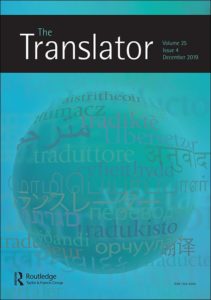[CFP] The Translator Special Issue: Translating Hazards
 The Translator Special Issue: Translating Hazards
The Translator Special Issue: Translating Hazards
Special Issue Editor(s)
Prof. Feredico M. Federici, Centre for Translation Studies, University College London
f.m.federici@ucl.ac.uk
Translating Hazards
Interpreters and translators regularly work communicating hazards so that the recipients of information can take informed decisions on what risks they are prepared to take. Anthropological, cultural, and ethnographic studies have considered the influence of culture and ethnic backgrounds in the field of disaster risk reduction, but the impact of translation in all its modes and formats has been studied much less (see O’Brien and Federici 2019; Federici 2020). This is paradoxical as perception of risk is conditioned by emotive and cognitive responses (Ponari et al., 2015); humans avoid taking risks or engage with risks because of our evolutionary adaptive abilities (we adapt to the environment and adapt the environment to us). “People judge a risk not only by what they think about it but also by how they feel about it” (Slovic & Peters, 2006, p. 323), and we interact with risks in culture-specific ways (Appleby-Arnold et al. 2018; Cornia, Dressel, & Pfeil, 2014; Douglas & Wildavsky, 1983). Within social groups, humans frequently underestimate certain risks and over-estimate others.
Communicating risks to people, properties, and places is an act that relates to security and safety. In fact, the distinction between risks and hazards is crucial for translation and interpreting research: “The potential to harm a target such as human health or the environment is normally defined as a hazard, whereas risk also encompasses the probability of exposure and the extent of damage” (Scheer et al. 2014).
To secure the health of intercultural and multilingual populations, imminent risks, when hazards disrupt ordinary routines and a crisis erupts, must be communicated clearly. To ensure safety, information must also be trusted (Cadwell 2019). Additionally, the impact of any risk is closely linked to the vulnerability of the local populations, which is exacerbated by socio-economic and racial inequalities. Risk communication therefore is not only cultural, it is also a question of language clarity, language efficiency, and linguistic equality.
Translating hazards inherently refers to ecosystems and pertains to the increasingly devastating effects of climate change as much as to risk communication. Natural hazards are ever-changing in connection with humans’ abuse of our planet, but the risks that politicians and people are willing to take quickly alter our social, economic, and cultural vulnerabilities to such hazards and their cascading effects. Understanding risks and communicating them efficiently is crucial during the response to a disaster in a multilingual setting where interpreters are called to incredible efforts, as much as in scientific translation of papers enlarging our understanding of new phenomena that reveal the effects of climate change (Kelman 2020).
Recent publications have focused on aspects of language and culture mediation in emergency contexts (e.g. Alexander and Pescaroli 2019; Federici 2016; Federici and Declercq 2019; O’Brien and Federici 2019) and previously translation in conflict areas (e.g. Salama-Carr 2007; Tesseur 2019) and their narratives (Baker 2006). These works indicate that we have barely started investigating the relationships between risk perception and communication of hazards in superdiverse and linguistically complex societies. Interpreters and translators play significant roles that have remained under-researched. This special issue hopes to further the research agenda in connection with communicating risks and hazards and the centrality of culture, language, and society in individuals’ perception of them. The special issue invites contributions that explore translating, interpreting, and voicing risks and hazards in multimodal formats and with cross-disciplinary approaches.
Themes and topics focusing on translation, interpreting, and cross-cultural communication in relation to hazards may include but are not limited to:
- Environmental hazards: climate change, changes to places, changes to populations, changes to cultures
- Technological hazards: from communicating cybersecurity and attacks to telecommunications to risk perception in remote interpreting
- Communicating health risks: local, cross-border, and global challenges
- Financial and economic risks
- Hazards and risks affecting professional translators and interpreters’ activities as well as those of ‘fixers’
- Terminological challenges of translating ‘hazard’, ‘risk’, ‘security’, and ‘safety’ across distant and different legal and cultural systems
- Accessibility, language equality, linguistic diversity, and risks
- Infrastructural hazards and risks related to designing, devising, and deploying sophisticated translation technologies (e.g. server space, electrical consumption, HPC requirements)
- Deontology and ethics of communicating hazards to multilingual audiences
- Experimental research on risk perception in relation to first, second, third language and translation activity
- Policy implications of communicating risks and hazards in multilingual contexts
Submission Instructions
Articles shall be between 6,000 and 8,000 words in length (including notes and references) and written in English. Style guidelines are available on the Instructions for Authors section of the journal homepage. Abstracts of 500 words should be sent by email to the guest editor at f.m.federici@ucl.ac.uk by 30 October 2020.
Schedule:
30 October 2020: deadline for submitting 500-word abstracts to the guest editor
30 November 2020: notification of acceptance or rejection of abstracts
31 March 2021: submission of papers
30 September 2021: confirmation of acceptance
15 December 2021: submission of final revisions
